
|
![]()
Greatest Films of the 1930s
1930 | 1931 | 1932 | 1933 | 1934 | 1935 | 1936 | 1937 | 1938 | 1939
Title Screen Film Genre(s), Title, Year, (Country), Length, Director, Description 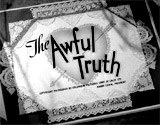

The Awful Truth (1937), 90 minutes, D: Leo McCarey
A classic screwball comedy of the 1930s, filmed previously in 1925 and 1929, and remade as the musical Let's Do It Again (1953). Based on Arthur Richman's 1922 play, and the first on-screen pairing of Irene Dunne and Cary Grant. After an argument and a series of false accusations, married couple Jerry (Cary Grant) and socialite Lucy Warriner (Irene Dunne) agreed to a 90 day interlocutory divorce. He pursued singer Dixie Belle Lee (Joyce Compton) and socialite Barbara Vance (Molly Lamont), while she saw both her handsome voice teacher Armand Duvalle (Alex D'Arcy) and wealthy oil heir Daniel Leeson (Ralph Bellamy). With rapid-fire, witty and sophisticated dialogue, they each tried their best to thwart or sabotage each other's romances and marriage plans with others, and bickered over who got custody of their pet terrier Mr. Smith (Asta of The Thin Man). By the end, they both discovered the awful truth that they still loved each other.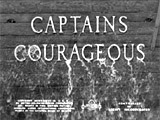




Captains Courageous (1937), 115 minutes, D: Victor Fleming
Rudyard Kipling's tale of adventure, an MGM classic, and remade as two TV movies in 1977 and 1996. A spoiled young heir Harvey Cheyne (Freddie Bartholomew), the son of shipping magnate Mr. Cheyne (Melvyn Douglas) fell overboard from a luxury ocean liner and was rescued by a simple, crusty Portuguese fisherman Manuel (Oscar-winning Spencer Tracy). He was brought on board a New England, Nantucket fishing schooner, and immediately demanded to be brought to shore. They boy was forced to remain onboard for the remaining part of their 3-month fishing trip, and work to earn his keep. He was taught a love of the sea and a valuable series of lessons on life, humility, work, trust, love, and courage. Gradually, he was transformed into a different lad.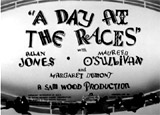



A Day at the Races (1937), 109 minutes, D: Sam Wood
One of the best Marx Brothers films, made during their peak years for MGM. A follow-up film to their successful A Night at the Opera (1935) from a few years earlier. Horse doctor veterinarian Dr. Hugo Hackenbush (Groucho Marx) pretended to be a psychiatrist and was hired by a wealthy hypochondriac Mrs. Upjohn (Margaret Dumont) to run a sanitarium that she was financing. Instead, he went to the horse races, where he received racing tips from Tony (Chico Marx) in the famous "tootsie-frootsie" ice cream scene. With other memorable scenes and wild comedy routines.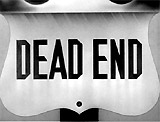

Dead End (1937), 92 minutes, D: William Wyler
Adapted from Sidney Kingsley's hit Broadway play, with a script by Lillian Hellman, and set in the Depression. A social drama about the harsh realities of the ugly, oppressive environment of New York City slums and tenements in the 1930s, with poverty and crime. A cold-blooded career gangster Baby Face Martin (Humphrey Bogart) returned to his boyhood neighborhood for a visit - a dead end street in a lower East Side slum, and became an unwelcome influence on the street kids (dubbed the Dead End Kids, and later known as the Bowery Boys). This plot vignette was intercut with two other stories about residents struggling to make a living: the plight of young architect Dave (Joel McCrea) who opposed his boyhood friend Martin, and dreamt of rebuilding the depressed waterfront area, and the story of working girl Drina (Sylvia Sidney) whose brother Tommy (Billy Halop), one of the neighborhood Dead End Kids, idolized Martin and was being negatively influenced by him.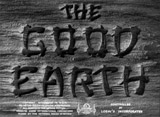


The Good Earth (1937), 138 minutes, D: Sidney Franklin
MGM's beautiful film production - producer Irving Thalberg's last picture - of Pearl Buck's 1931 Pulitzer Prize-winning novel about a peasant couple in rural China. A simple, poor Chinese rice farmer Wang Lung (Paul Muni) wed O-Lan (Best Actress-winning Luise Rainer, two years in a row) in an arranged marriage. They were forced to endure hard labor, poverty, and a severe drought and famine. During government strife and a revolution that swept through the land, their lives were transformed and he became the wealthiest landowner in the province. Their efforts and their family disintegrated from his all-consuming greed for money and the devastating effects of a swarm of locusts. In the end, he learned too late that his long-neglected, self-sacrificing, saintly wife was the one who had held everything together.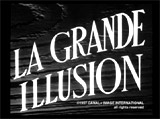

Grand Illusion (1937, Fr.) (aka La Grande Illusion), 114 minutes, D: Jean Renoir
This Nazi-banned, anti-war masterpiece was the first foreign film to be nominated for an Academy Award for Best Picture. In the late 1930s, French filmmaker Jean Renoir attempted to signal a warning about warfare's 'grand illusions' with this classic film, set in a WWI German prison camp in 1916. The film, for the most part, only implied that a war was occurring outside the prison. Aristocratic French officer Captain de Boeldieu (Pierre Fresnay) faced a dilemma regarding his escape with other POWs, including working class mechanic French officer/hero Lieut. Maréchal (Jean Gabin) and wealthy middle-class Jew Lieut. Rosenthal (Marcel Dalio). They were imprisoned and under the watchful eye of stiff German Captain von Rauffenstein (Eric von Stroheim), with a neck brace and wearing a monocle - the commandant of Wintersborn, the German's maximum-security camp. Boeldieu sacrificed himself when reluctantly shot by von Rauffenstein, to allow Marechal and Lieutenant Rosenthal to escape. There was a touching deathbed farewell to Boeldieu from the consoling German commandant. Ultimately, the two escapees took refuge with widowed German farm woman Elsa (Dita Parlo), and found safety and freedom across the Alps and into Switzerland on the border. In the film's last line, one of the soldiers who spotted them shouted: "Don't shoot! They are in Switzerland," to which another responded: "All the better for them."

The Hurricane (1937), 103 minutes, D: John Ford
A spectacular disaster film and tropical fantasy set in the South Seas, followed by an inferior remake in 1979. With a lush film score by composer Alfred Newman. A native named Terangi (Jon Hall) from the island of Manakoora, married his childhood sweetheart Marama (Dorothy Lamour). Terangi was convicted of attacking a white man and imprisoned. He was repeatedly sentenced to longer and longer terms of imprisonment for making failed escape attempts. His case was appealed to the island's new white governor Eugene De Laage (Raymond Massey), who was a strict by-the-book disciplinarian, although his wife was sympathetic to Terangi's plight. The film ended with a climactic hurricane sequence with great special effects.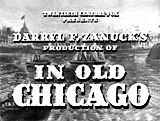

In Old Chicago (1937), 115/95 minutes, D: Henry King
Darryl F. Zanuck's disaster film and romantic drama was designed to take advantage and piggyback upon the success of MGM's previous year's hit San Francisco (1936). The screenplay by Lamar Trotti and Sonya Levien was based on a story by Niven Busch. The story was about a strong rivalry between two of the three sons of widowed, strong-willed matriarch Mrs. Molly O'Leary (Alice Brady), the one whose cow reportedly kicked over a lantern and started the Chicago fire. Her youngest son was Bob (Tom Brown), a mother's helper who flirted with the pretty Swedish servant Gretchen (June Storey). The two eldest O'Leary sons took very different paths and were in fierce conflict: a virtuous good son, an honest and reforming lawyer Jack (Don Ameche) running for mayor, and a bad son - a corrupt yet charming gambling saloon owner and scheming, devious rogue Dion (Tyrone Power). Dion's assistant was singer Belle Fawcett (Alice Faye), also his business partner and lover. Chicago boss Gil Warren (Brian Donlevy) wanted to destroy both brothers. The quasi-historical film climaxed with a spectacular 20-minute sequence of the Chicago fire of 1871, with an abrupt inspirational ending. The Chicago Historical Society assisted in the picture's historical accuracy, although much of the film was fictionalized.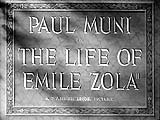



The Life of Emile Zola (1937), 123 minutes, D: William Dieterle
The Best Picture-winning film biography of the famous 19th century French intellectual and novelist, the first film to receive 10 Academy Award nominations, and the second biographical film to win the Academy Award for Best Picture after The Great Ziegfeld (1936). Director Dieterle directed star Paul Muni in two other historical dramas: The Story of Louis Pasteur (1936), and Juarez (1939). The tale of Zola was remade in José Ferrer's film I Accuse! (1958) with a screenplay by Gore Vidal. The film traced the life of Emile Zola (Paul Muni in another of his many biopics) from his youth, as a friend of Paul Cezanne (Vladimir Sokoloff) starving in a Parisian attic, to the peak of his career. He was celebrated as France's greatest author and the champion of the oppressed. The actual trial involving Zola, a celebrated French writer and social critic, occurred in February 1898. He had been defending and fighting for the pardon of French military officer Capt. Alfred Dreyfus (Joseph Schildkraut), a Jewish officer in the French army who was wrongly-accused (and unjustly court-martialed) on the charge of treason for providing secret information to the Germans - he was sentenced to a slow death by life imprisonment on Devil's Island. When new information came to light about Dreyfus' innocence and it appeared to be a cover-up, Zola risked his own life and fame (it was on the eve of membership to the French academy) by agreeing to defend Dreyfus - the so-called Dreyfus Affair. [The real criminal, French major Count Esterhazy, had divulged French military secrets to the Germans, but was found innocent in a rigged court martial hearing.] Zola published his famous "I Accuse" letter to directly accuse the French military of ignoring Dreyfus' innocence and falsely convicting him to protect Esterhazy's guilt. Zola was charged with criminal libel. The trial was a farce - Zola was bullied and discredited while crucial evidence was neglected and false claims were made, even though Zola made strong emotional and personal pleas (Zola's final address to the jury in the film was taken from "I Accuse," not from the actual trial). The highlight of the film was Zola's famous six minute courtroom speech. Zola was convicted and sentenced to a year in prison. However, Zola's conviction was overturned on appeal, although he had already fled to London. Zola was never imprisoned. He returned to Paris, France after 18 months in exile, and died an accidental death in 1902 (carbon monoxide poisoning), before the courts fully exonerated Dreyfus in 1906. (Dreyfus was tried a second time, and again convicted and sentenced to 10 years in prison, but quickly pardoned by the French Republic President, and restored to his army rank).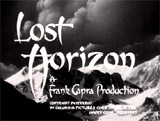




Lost Horizon (1937), 138 minutes, D: Frank Capra
Capra's telling of James Hilton's 1933 book - escapist, idealistic and naive. Escapees and refugees fleeing from a Chinese revolution in Bakul boarded a plane bound for Shanghai that crash-landed, and five survivors were led through the icy Himalayans by Chinese monk Chang (H. B. Warner) to a magical enchanted paradise, a hidden Tibetan utopia at the top of the world named Shangri-La. There in the peaceful valley, war and death and financial panic were unknown, people lived almost forever (time had stopped) and everyone followed the law of "Be kind." Shangri-La's wisest man was the High Lama (Sam Jaffe), originally known as missionary Belgian priest, Father Perrault, who wished to have one of the group's members, British diplomat Robert Conway (Ronald Colman) be his successor. Conway was a romantic dreamer who believed he had found a new home and a new romantic interest when he fell in love with the ethereally beautiful Sondra (Jane Wyatt). He was convinced, however, by his younger brother George Conway (John Howard) to leave. The film's most startling scene was when George's Shangri-La lover, 20-year-old Russian girl Maria (Margo) accompanied him and she died an old wrinkled and withered woman (aging by half a century, the time she spent in the valley). Despairing and hysterically crazed after an abrupt return to the world of time and death, George committed suicide by throwing himself off a cliff ledge. Conway struggled to get back to England, where he was haunted by his memories of his time in the idyllic valley, especially with Sondra, and he made an effort to return. The film ended with a toast and salute to the missing Conway: "Here's my hope that Robert Conway will find his Shangri-La. Here's my hope that we all find our Shangri-La."


Make Way For Tomorrow (1937), 91 minutes, D: Leo McCarey
One of the saddest and most poignant and sentimental films ever made (similar to Ozu's Tokyo Story (1953)), during the weary end years of the long drawn-out Depression, about the harsh realities of aging. Although beautifully realized, it was not a hit at the box-office and was forgotten for many years. Based on Josephine Lawrence's novel The Years Are So Long. Financially-distraught elderly couple Ma and Pa Cooper - Barkley (Victor Moore) and Lucy (Beulah Bondi), married for 50 years, lost their foreclosed house to the bank when they could not make the mortgage payments. They requested aid from their five children for housing or assistance, and there was a temporary solution - although the couple were forced to separate: Lucy would move to New York to live in the apartment of eldest son George's (Thomas Mitchell) family, while Barkley would be 360 miles away at the home of mean-spirited daughter Cora Payne (Elisabeth Risdon) and her unemployed husband Bill (Ralph Remley). Accommodations in New York for Lucy were cramped, with George's wife Anita (Fay Bainter) and daughter Rhoda (Barbara Read) upset with the disruption and intrusion. To not be a burden, Lucy ended up in a female retirement-nursing home, and Barkley decided to travel to the warmer climate of California for health reasons, to live with unseen daughter Addie. They shared a heartbreaking farewell at the same NY train station as their honeymoon years earlier, in the film's downbeat ending.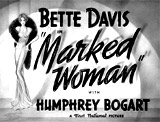



Marked Woman (1937), 99 minutes, D: Lloyd Bacon
At the time of this film's making, Bette Davis had become disillusioned by the poorly-scripted films being offered to her by Warner Bros. studio. She fled to Europe to further her career, although was brought back by a lawsuit (that she contested and lost) and forced to make this hard-boiled film - an urban crime melodrama based on the real-life story of NYC vice lord Charles "Lucky" Luciano. It was the story of a nightclub hostess ("prostitute") Mary Dwight (Bette Davis), who worked at the Club Intime (a "clip joint") as a party girl, owned and operated by a notorious "Lucky" Luciano-type gangster Johnny Vanning (Edward Ciannelli). Special prosecutor and crusading district attorney David Graham (Humphrey Bogart) tried to convince Mary (at first unsuccessfully) to be a key witness to testify against her crooked boss - first for murdering one of the debt-owing customers Ralph Krawford (Damian O'Flynn) and then for killing her innocent younger sister Betty (Jane Bryan), by slugging her down a staircase to her death. To threaten and scare her, Vanning scarred Mary's face, making her a "marked woman." This convinced her to finally testify in court with other hostesses to convict the abusive gangster (and sentence him to the electric chair) who regularly beat and mistreated his brothel prostitutes. [Note: In real life in 1936, celebrated Special Prosecutor Thomas E. Dewey put Lucky Luciano behind bars on prostitution charges.]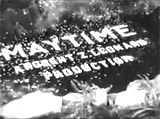




Maytime (1937), 132 minutes, D: Robert Z. Leonard
The third film pairing MacDonald and Eddy, a musical drama-romance (adapted from the operetta by Rida Johnson Young) once popular but mostly forgotten nowadays. In 1906, an aged opera singer Marcia Morney (Jeanette MacDonald) lived with her longtime loyal maid Ellen (Rafaela Ottiano). Morney related in flashback the story of her life forty years earlier. She told of her love for poor baritone singer Paul Allison (Nelson Eddy) and their idyllic time together at a May Day festival, but instead married Svengali-like impresario-trainer Nicolai Nazaroff (John Barrymore). After several years, she co-starred with Paul in an American opera production and their love was rekindled, leading to tragic consequences for the two lovers when Nicolai's jealousy overtook them and he shot Paul dead. Concluded with a magnificent sequence of the spiritual images of the doomed lovers meeting together on a flower-strewn path and reprising "Will You Remember (Sweetheart)?" Also included the musical numbers: "Mammy's L'il Baby Loves Shortnin' Bread," "Carry Me Back to Old Virginny," and "Czaritza" - an adaptation of Tchaikovsky's 5th Symphony with modern lyrics.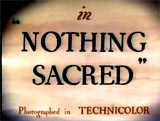

Nothing Sacred (1937), 75 minutes, D: William A. Wellman
A superb screwball comedy (the first filmed in color) from former newspaperman and scriptwriter Ben Hecht (who also wrote the play "The Front Page" - made into another famous screwball comedy His Girl Friday (1940)). The comedy satirized the world of tabloid reporting and its corruption and dishonesty. Remade as Living It Up (1954) with Dean Martin, Jerry Lewis, and Janet Leigh. An incompetent Dr. Enoch Downer (Charles Winninger) diagnosed a simple Warsaw, Vermont woman Hazel Flagg (Carole Lombard in her most beloved role) as having only six weeks to live due to radium radioactive poisoning. A small-town newspaper's cynical ambitious reporter Wally Cook (Fredric March), who had already been reprimanded for printing exaggerated stories in the Morning Star, arrived in Vermont to get the exclusive story. In the meantime, Flagg had been told by Dr. Downer that he had mis-diagnosed her, and that she was healthy. Nonetheless, she accepted an all-expenses-paid trip to NYC with Cook, to honor her courage and heroism. In the big city of New York, she became a national hero (with a ticker-tape parade and presentation of the key to the city). Soon after, her conscience caused her to want to confess the entire hoax about how her diagnosis had been changed and that she was not dying. When the obvious ruse was ultimately about to be revealed, it was decided that Cook and Flagg (who had fallen in love and married) would make their honeymoon getaway to a tropical island, while it was rumored that she had committed suicide with a note left behind.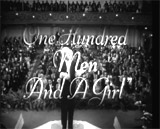


One Hundred Men and a Girl (1937), 85 minutes, D: Henry Koster
A musical comedy, starring teenaged singing sensation Deanna Durbin, and conductor Leopold Stokowski in his first feature film (his next one was Fantasia (1940)). An irrepressible young girl Patricia "Patsy" Cardwell (Deanna Durbin) pestered a great conductor (Leopold Stokowski playing himself) to form an orchestra comprised of her unemployed trombonist/musician father John Cardwell (Adolphe Menjou) and ninety-nine of his closest friends.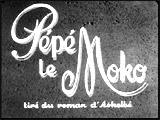


Pépé le Moko (1937, Fr.), 94 minutes, D: Julien Duvivier
An early pre-film noir, and example of French poetic realism. Remade in the US as Algiers (1938) with Hedy Lamarr and Charles Boyer, and remarkably similar (in parts) to Casablanca (1942). In the 1930s, Parisian underworld tough-guy yet dashing gangster Pépé le Moko (Jean Gabin) hid out in the Casbah (a winding district of alleys, hideouts, crowded streets and markets) in Algiers, to evade French and Algerian police. After a period of two years ruling but also imprisoned there, he longed to be free and enjoy the good life in Paris and Marseilles. One night after a shootout with authorities, he met gorgeous Parisian socialite Gaby Gould (Mireille Balin), the kept woman of a rich older man (in the champagne business) - and they began a romance. Pépé's jealous lover Inès (Line Noro) taunted him: "No more Paris, no more Marseilles, nothing but the Casbah!" Algerian inspector Slimane (Lucas Gridoux) plotted to arrest Pépé by coaxing him out of the Casbah, using Gaby as attractive bait.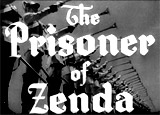



The Prisoner of Zenda (1937), 101 minutes, D: John Cromwell
The best version of the many remakes and versions (1913, 1915, 1922, 1952, and 1979) of Anthony Hope's novel, a swashbuckling adventure tale. The 1952 version, a shot-for-shot remake by MGM starred Stewart Granger and Deborah Kerr. This was the masquerade story of an Englishman commoner, Rudolph Rassendyl (Ronald Colman), who was on holiday in the small central European country of Ruritania. He thwarted a revolutionary assassination plot when called upon to sit on the royal throne for his cousin and lookalike, the kidnapped soon-to-be-crowned King Rudolf V (also Ronald Colman). Behind the plot was a band of rebels led by the crown prince's evil brother Black Michael (Raymond Massey) and his dashing villain henchman Rupert of Hentzau (Douglas Fairbanks, Jr.). Included swashbuckling sword fights and a romance between the commoner/king and the regally-beautiful Princess Flavia (Madeleine Carroll).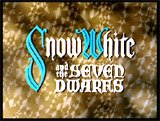


Snow White and the Seven Dwarfs (1937), 82 minutes, D: Disney Studios (David Hand)
Disney's first full-length animated feature (and the first in film history), based on the Brothers Grimm imaginative storybook fairy tale, and one of the most culturally significant films ever made. The film was costly at $1.7 million, and took 3-4 years to complete. The film was the story of a young, beautiful but victimized, rags-wearing servant girl Snow White who was brought up by her evil stepmother, the vain, wicked and jealous queen. When told that the "fairest of them all" was Snow White, the queen had her huntsman take Snow White to the forest to kill her and return with her heart. The huntsman could not carry out the gruesome task, and freed Snow White, who ran into the forest and was adopted by woodland creatures. She sought refuge in the cottage of the loveable seven dwarfs, diamond-mine workers. When the wicked, jealous queen learned from her Magic Mirror that Snow White was still alive, she transformed herself into an old hag beggar woman, and offered Snow White a bite from a poisoned apple. Snow White entered into a comatose deep sleep (within a glass-and-gold coffin) until she was awakened from the sleeping death by Prince Charming's loving kiss. A timeless classic with sing-along-songs, including: "Heigh Ho," "Whistle While You Work," and "Someday My Prince Will Come."
Song at Midnight (1937, China) (aka Ye Ban Ge Sheng), 113 minutes, D: Weibang Ma-Xu
The first Chinese horror film, remade as Ronny Yu's bigger-budgeted Phantom Lover (1995) starring Leslie Cheung, and a variation or reinterpretation of Gaston Leroux's novel The Phantom of the Opera and Rupert Julian's film The Phantom of the Opera (1925) with Lon Chaney, Sr. An artistically-made work of art, with opera singer Song Dan-ping (the Erik the Phantom anti-hero character) (played by Jin Shan), who fell in love with Li Xiaoxia (Ping Hu), the daughter of General Wan-Yin (Woo Ping). The disapproving father punished Dan-ping by disfiguring his face with acid. Mutilated and feeling shameful about his looks, Dan-ping spread the rumor that he was dead, causing his lover to go mad with grief. Ten years later, a young opera singer Sung Xiaoou (Chau-Shui Yee) met Dan-ping by accident hiding in the opera house, and discovered his fateful past.



Stage Door (1937), 83 minutes, D: Gregory La Cava
A film adaptation based on the Edna Ferber/George S. Kaufman play about a New York boarding house filled with hopeful and aspiring theater actresses (many were soon-to-be famous stars of the 30s and 40s). An entertaining Hollywood backstage, behind-the-scenes comedy/drama of the lives and ambitions of actresses and stage hopefuls who lived together in a theatrical boarding house. They included the privileged and wealthy debutante Terry Randall (Katharine Hepburn) who was trying to make it on her own without the help of her family's money, her rival and sarcastic tough-cookie roommate Jean Maitland (Ginger Rogers), and high-strung depressed actress Kaye Hamilton (Andrea Leeds). Jean allowed leering producer mogul Anthony Powell (Adolphe Menjou) to take her out only to insure getting a part, but Terry got the lead because her father had backed and financed the production without her knowledge, causing despair and jealousy among the others. With great, sharp-tongued dialogue and a realistic, almost all-girl cast.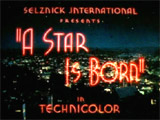

A Star is Born (1937), 111 minutes, D: William A. Wellman
The first of three film adaptations, this non-musical version was one of the best of Hollywood's behind-the-scenes tragic dramas, featuring a star-crossed romance. The script borrowed from the lives of real-life Hollywood failures, including John Gilbert, John Barrymore, and Wallace Reid. Followed by two remakes: A Star Is Born (1954) with Judy Garland and James Mason, and A Star is Born (1976) with Barbra Streisand and Kris Kristofferson. A successful but alcoholic, self-destructive, aging superstar actor Norman Maine (Fredric March) met, fell in love with, and married a charming, talented young newcomer/hopeful Esther Blodgett/Vicki Lester (Janet Gaynor). With his influence, she was introduced to powerful Hollywood figures including studio producer/director Oliver Niles (Adolphe Menjou). After being discovered, her career blossomed and she enjoyed a meteoric rise to stardom, contrasted with Norman's slow decline, unemployable status, and self-destruction, sinking deeper into alcoholism. Eventually, he met a despairing suicidal end after visiting a sanitarium and jail.

Stella Dallas (1937), 105 minutes, D: King Vidor
A classic and popular dramatic tearjerker/soap-opera about clashing social values and a devoted mother's sacrificial love - the best version of three filmed attempts (a silent film in 1925, and a feature film in 1990 with Bette Midler). It was also a best-selling novel by Olive Higgins Prouty, a play (without a Broadway run), and a radio serial that played for 18 years. The film was the touching portrayal of an upwardly mobile, small-town, good-hearted mill-girl named Stella Martin (Barbara Stanwyck) who married a down-on-his-luck heir Stephen Dallas (John Boles). She entered into money when he became a successful businessman, but was never able to escape her vulgar, hard-living and coarse middle-class ways. She lost her husband when he left her for a former love, the widowed, society-bred Helen Morrison (Barbara O'Neil). She then gave up their daughter Laurel (Anne Shirley) to her wealthy father, in a supreme act of self-sacrifice and selflessness. She affirmed she would not get in the way of her daughter's happiness or her social and romantic aspirations (allowing Laurel to marry into a wealthy family). The tearjerking ending was unforgettable, as she watched her daughter's happy marriage from afar.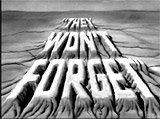


They Won't Forget (1937), 94 minutes, D: Mervyn LeRoy
The setting for this liberal outrage film was the small (fictional) Southern town of Flodden, Georgia in the 1920s, where townsfolk (especially Civil War veterans) were preparing for the annual Confederate Memorial Day parade. The film opened with the murder of Buxton Business College student Mary Clay (this was the debut film of Lana Turner - a bit part including her famous tight-sweater walk), whose body was found by black janitor Tump Redwine (Clinton Rosemond) in the school's basement. Present close to the murder scene were Mary's shorthand teacher Robert Perry Hale (Edward Norris) - an unhappily-transplanted Yankee Northerner, the frightened Redwine, and Dean Buxton (E. Alyn Warren). Ambitious D.A. Andy Griffin (Claude Rains) saw the case as his ticket to the Senate - and he immediately suspected Hale, who was arrested. Detective Pindar (Granville Bates) was assigned to investigate, while weak defense attorney Michael Gleason (Otto Kruger) was selected to defend Hale, who was viciously subjected to anti-northern prejudice, local anger and hate, fueled by reporter Bill Brock (Allyn Joslyn) and Mary's vengeful redneck brothers who wanted a lynching. [The story was directly based on the notoriously lawless Leo Frank lynching in Marietta, Georgia in 1915 after the murder of Mary Phagan.] During the trial - a gross miscarriage of justice with many instances of perjury, the histrionic Griffin basically presented 'circumstantial evidence' to vilify Hale as the guilty one: (1) there was blood on Hale's coat (Hale claimed it was from a shave on Main St., although the barber lied and denied it), (2) the unfortunate fact that Hale was planning to quit and leave town at the time of the murder. Hale took the stand and pleaded his innocence, but was not cross-examined. The jury swiftly brought a guilty verdict (although one juror wavered briefly), affirmed by the Supreme Court, although Governor Mountford (Paul Everton) commuted the death sentence to life imprisonment. The train carrying Hale to prison was stopped by a lynch mob (led by the Clay brothers) - and Hale was hanged. Hale's guilt or innocence was never clarified.



Topper (1937), 98 minutes, D: Norman Z. McLeod
A delightful comedy/fantasy that was followed by two sequels: Norman Z. McLeod's Topper Takes a Trip (1938) (without Cary Grant) and Roy Del Ruth's Topper Returns (1941), a 1953-1955 TV series with Leo G. Carroll as the title character, and two TV movies, Topper (1973) (with Roddy McDowall) and Topper (1979) (with Jack Warden). It told about a free-spirited, wealthy, fun-loving couple named George (Cary Grant) and Marion Kerby (Constance Bennett), with wealth, fast cars, and excessive partying. The happy-go-lucky married duo were killed in an auto accident when they crashed their roadster into a tree. Before they were granted entrance to heaven, however, they had to perform a good deed for their stuffy bank president - to teach mild-mannered proper Cosmo Topper (Roland Young) to liven up, relax and enjoy life's pleasures. They appeared at will as haunting invisible ghosts, often at awkward moments, but were only seen by Topper - taking pleasure at embarrassing him in humorous predicaments. In one hilarious scene, the Kerbys helped the drunken Topper down a hotel staircase and through the lobby.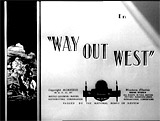


Way Out West (1937), 65 minutes, D: James W. Horne
Possibly the best Laurel and Hardy comedy (with tremendous slapstick), in a western setting. Stan Laurel (Himself) and Oliver Hardy (Himself) agreed to deliver a gold mine deed and map for deceased prospector friend/partner Seymore "Sy" Roberts (Tex Driscoll). They traveled west to Brushwood Gulch to give the rightful inheritance to the prospector's daughter Mary Roberts (Rosina Lawrence), but along the way, a crooked bartender Mickey Finn (James Finlayson) learned of their mission and persuaded his floozy barmaid/girlfriend Lola Marcel (Sharon Lynne) to pose as an imposter and hijack the map and deed. When the two learned they were deceived, they had to get the map back and rescue the girl. Included a delightful soft-shoe dance sequence of the comedic pair to "At the Ball, That's All," the singing of "The Trail Of The Lonesome Pine," a hilarious chase scene to get the deed, Stan's tickling-to-death scene, the attempt to sneak into the saloon using Dinah the Mule, and the concluding song: "We're Going to Go Way Down to Dixie."